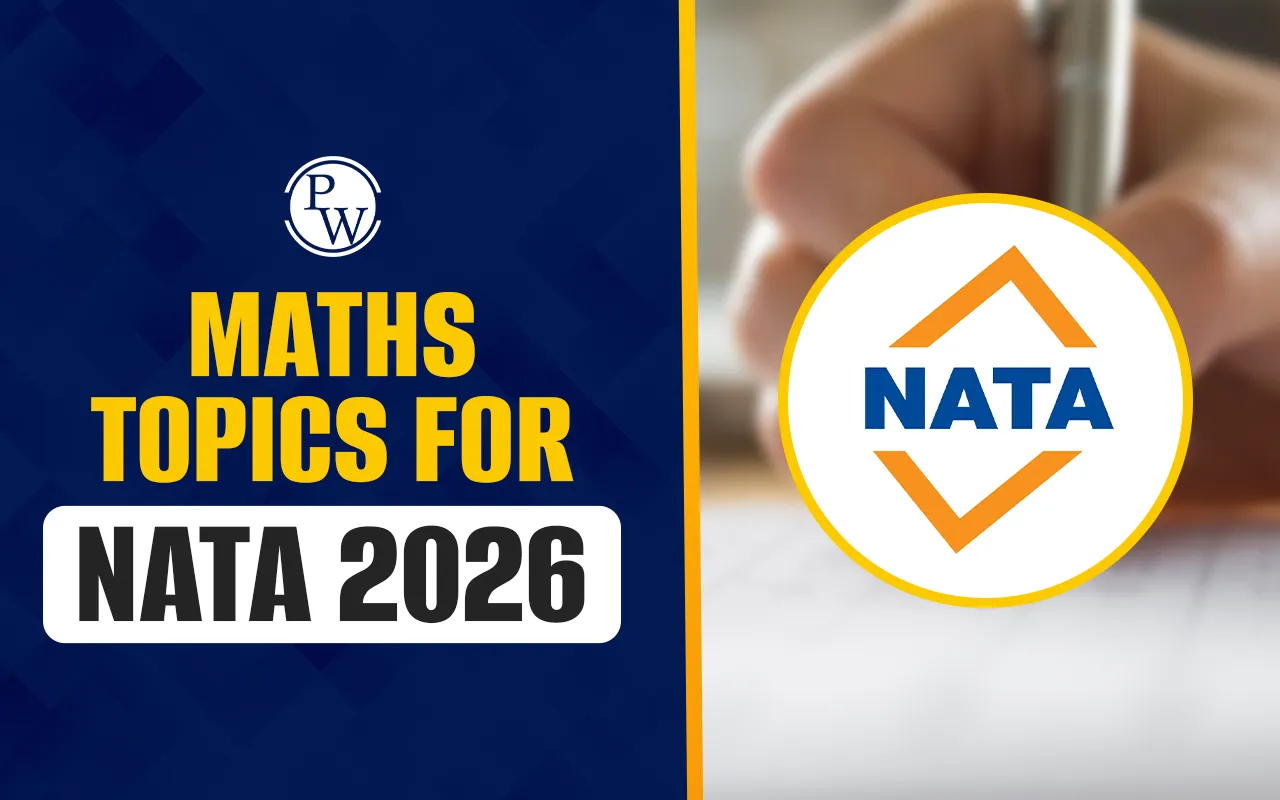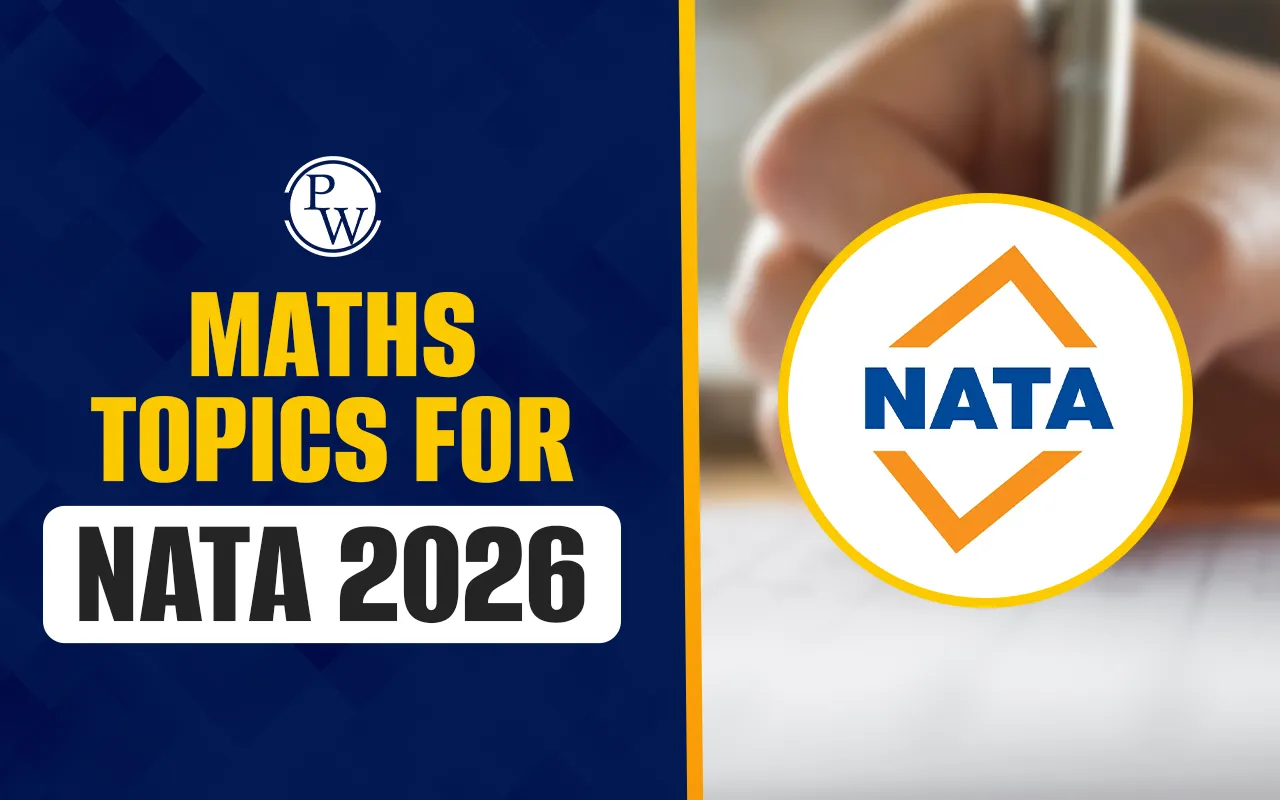

NATA 2026 Maths Topics play an important role in determining your overall performance in the National Aptitude Test in Architecture (NATA). Since architecture requires analytical and spatial understanding, a strong grasp of mathematics can improve your aptitude scores and design ability.
NATA Maths focuses less on lengthy calculations and more on conceptual application. NATA Maths Syllabus 2026 primarily covers Class XI and XII mathematics. It emphasizes geometry, algebra, and trigonometry. These topics directly link to architecture and design logic.
NATA 2026 Maths Topics Overview
NATA 2026 Maths Topics form the backbone of the aptitude section. This part of the exam assesses mathematical knowledge as well as logical and visual reasoning. These are vital in architectural problem-solving.
NATA Maths Syllabus 2026 draws from concepts covered in Classes 11 and 12 but applies them in design-oriented contexts. Students should expect a balance between direct numerical questions and those testing analytical application
NATA Maths Syllabus 2026
The NATA Maths Syllabus 2026 evaluates analytical, spatial, and quantitative reasoning abilities. Mathematics in NATA checks your ability to visualize dimensions, solve geometric problems, and apply algebraic logic. The detailed syllabus is given below:
-
Algebra: Definitions of A. P. and G.P.; General term; Summation of first n-terms of series Σn, Σn²,Σn3 ; Arithmetic/Geometric series, A.M., G.M. and their relation; Infinite G.P. series and its sum.
-
Logarithms: Definition; General properties; Change of base.
-
Matrices: Concepts of m x n (m ≤ 3, n ≤ 3) real matrices, operations of addition, scalar multiplication and multiplication of matrices. Transpose of a matrix. Determinant of a square matrix. Properties of determinants (statement only). Minor, cofactor and adjoint of a matrix. Nonsingular matrix. Inverse of a matrix. Finding the area of a triangle. Solutions of a system of linear equations. (Not more than 3 variables).
-
Trigonometry: Trigonometric functions, addition and subtraction formulae, formulae involving multiple and submultiple angles, general solution of trigonometric equations. Properties of triangles, inverse trigonometric functions and their properties.
-
Coordinate geometry: Distance formula, section formula, area of a triangle, condition of collinearity of three points in a plane. Polar coordinates, transformation from Cartesian to polar coordinates and vice versa. Parallel transformation of axes, concept of locus, elementary locus problems. Slope of a line. Equation of lines in different forms, angle between two lines. Condition of perpendicularity and parallelism of two lines. Distance of a point from a line. Distance between two parallel lines. Lines through the point of intersection of two lines. Equation of a circle with a given centre and radius. A condition that a general equation of the second degree in x, y may represent a circle. Equation of a circle in terms of endpoints of a diameter. Equation of tangent, normal and chord. Parametric equation of a circle. Intersection of a line with a circle. Equation of the common chord of two intersecting circles.
-
3-Dimensional Co-ordinate geometry: Direction cosines and direction ratios, distance between two points and section formula, equation of a straight line, equation of a plane, distance of a point from a plane.
-
Theory of Calculus: Functions, composition of two functions and inverse of a function, limit, continuity, derivative, chain rule, derivative of implicit functions and functions defined parametrically. Integration is the reverse process of differentiation, the indefinite integral of standard functions. Integration by parts. Integration by substitution and partial fraction. Definite integral as a limit of a sum with equal subdivisions. Fundamental theorem of integral calculus and its applications. Properties of definite integrals. Formation of ordinary differential equations, solution of homogeneous differential equations, the separation of variables method, and linear first-order differential equations.
-
Application of Calculus: Tangents and normals, conditions of tangency. Determination of monotonicity, maxima and minima. Differential coefficient as a measure of rate. Motion in a straight line with constant acceleration. Geometric interpretation of definite integral as area, calculation of area bounded by elementary curves and Straight lines. Area of the region included between two elementary curves.
-
Permutation and combination: Permutation of n different things taken r at a time (r ≤ n). Permutation of n things not all different. Permutation with repetitions (circular permutation excluded). Combinations of n different things taken r at a time (r ≤ n). A combination of n things, not all different. Basic properties. Problems involving both permutations and combinations.
-
Statistics and Probability: Measure of dispersion, mean, variance and standard deviation, frequency distribution. Addition and multiplication rules of probability, conditional probability and Bayes’ Theorem, independence of events, repeated independent trials and Binomial distribution.
Important Maths Topics for NATA 2026
To manage your study time effectively, it’s essential to focus on the Important Maths Topics for NATA 2026 that carry higher marks or have been frequently asked in previous exams.
High-Weightage Topics
-
Coordinate Geometry: Questions on distance between points, slope, area of a triangle, circles, tangents, and conics.
-
Trigonometry: Identities, transformations, and solving geometric problems using sine and cosine rules.
-
Algebraic Series: Arithmetic and geometric progressions, AM-GM relationships, and series summations.
-
Matrices and Determinants: Solving simultaneous equations, properties of determinants, and application-based problems.
Moderate-Weightage Topics
-
Probability & Statistics: Simple probability questions and interpretation of statistical data.
-
Permutation and Combination: Commonly used in basic counting problems.
-
Logarithms: Law of logs, converting exponential equations.
Low-Weightage but Scoring Topics
-
Differentiation and Integration: Simple applications of derivatives and integrals.
-
Basic Arithmetic: Ratio, proportion, and percentage—sometimes integrated into geometry questions.
NATA Maths Preparation Tips
Effective planning can help you prepare well for the NATA exam. Here are some preparation tips for Maths:
-
Go through the NATA Maths Syllabus 2026 and divide it into small, manageable units. It is important to know what exactly you should study for complete coverage.
-
Use NCERT Mathematics (Class XI & XII) as your base. These books are simple, conceptual, and directly aligned with the Important Maths Topics for NATA.
-
After finishing each topic, summarize key formulas and methods on one page. These notes will save hours during revision.
-
While NATA is not extremely time-pressured, efficient solving is key. Learn shortcuts for basic calculations, and practice mental arithmetic.
-
Create visual flashcards for formulas related to Coordinate Geometry, Trigonometry, and Probability.
How to Prepare NATA Maths Previous Papers Effectively?
Practicing NATA Maths Previous Papers is important for candidates to improve accuracy, understand the exam structure, and identify high-weight areas from the NATA 2026 Maths Topics. Here’s how you should prepare using NATA Maths Previous Papers:
-
Before solving any paper, spend time analyzing the NATA maths question pattern from at least the past five years. See which Important Maths Topics for NATA appear repeatedly, for example, geometry, coordinate geometry, trigonometry, and algebra.
-
Begin by solving topic-specific questions from older papers. For instance, pick all NATA Geometry Questions from 2019–2024 and solve them together. Then move to algebra, mensuration, and so on.
-
Track your accuracy rate for every paper. Create a small table to record the number of correct, incorrect, and skipped questions.
-
NATA’s pattern checks conceptual clarity and visual reasoning. While revising NATA maths previous papers, note the variety, like the diagram-based geometry questions, numerical reasoning, or applied trigonometry.
-
After attempting a paper, go through the NATA Maths Syllabus 2026 and mark the chapters that frequently appear. Revise those sections again using NCERTs or reliable architecture preparation books.
NATA 2026 Maths Topics FAQs
What are the most important maths topics for NATA 2026?
The Important Maths Topics for NATA include coordinate geometry, trigonometry, algebraic progressions, and matrices.
Is the NATA maths section difficult?
How many questions are asked in geometry?
Around 20–25% of questions in NATA maths are geometry-based.
How can I prepare for NATA 2026 maths effectively?
Which books are best for NATA Maths preparation?
NCERT Maths (Class XI–XII) and previous year question compilations are useful books for NATA preparation.
